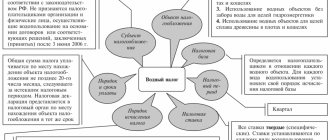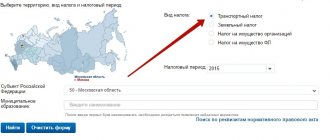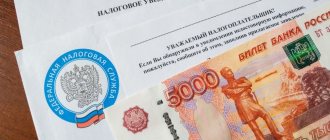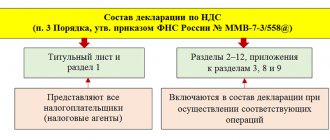Water tax rates for 2021 are set in relation to basic values and the values of special coefficients. Basic tariffs are fixed by the Tax Code. The responsibility for calculating and paying this tax rests with business entities that have a license for water use and use water resources.
Classification of rates is carried out in the context of types of water use and regions of the Russian Federation, according to belonging to a certain category of water source (river, lake, sea). Operations involving water intake, timber rafting, electricity generation and other forms of exploitation of water bodies may be taxed.
Features of water tax
Water tax is of a federal nature, therefore tax rates of water tax are established exclusively by the Tax Code of the Russian Federation. For water tax, the rates in 2021 are determined by Article 333.12 of the Tax Code of the Russian Federation.
Traditionally, for 2021, water tax rates are set depending on the type of use of water resources by an enterprise or individual entrepreneur (see the corresponding table below).
This article is presented in such a format that allows you to understand in the future what the dynamics of contributions to the water tax budget will be.
For example, water tax rates for 2021 must, in certain cases, be multiplied by a factor of 1.75:
- with excess water intake;
- lack of measuring instruments;
- extraction of water for sale.
How to calculate and pay water tax in 2021? Water tax declaration
The amount of water tax is calculated by the user independently. The arithmetic is quite simple and in 2021 it looks like this: Amount of water used * tax rate * coefficient 2.66
For example, residents of SNT Neftyanik (Moscow region) spent 5,000 m3 of water from a public well per quarter, in which case the calculation of the water tax will look like this: 5 (since the rate is set per 1,000 m3) *264 rubles * 2.66 Total: 3511.2 rub.
Don’t forget, if you exceed the water use limit, you will have to pay an increased tariff (five times the rate).
The tax return for water tax is submitted at the location of the facility. The form of this declaration was approved by order of the Ministry of Finance of the Russian Federation dated November 9, 2015 No. ММВ-7-3/ [email protected]
Rates for 2021
As noted, the size of water tax rates directly depends on the purposes of water use. For example, the water tax rate for water supply to the population (residential buildings):
- from 01.01.2017 to 31.12.2017 was 107 rubles per 1000 cubic meters. m of water resources;
- from 01/01/2018 to 12/31/2018 – is 122 rubles per 1000 cubic meters. m.
Water intake
When taking water within the limits of standards from surface and underground water bodies, the tax rate of water tax in 2018 is:
| Economic region | River basin, lake | Tax rate <*> in rubles per 1 thousand cubic meters. m of water taken from | |
| surface water bodies | underground water bodies | ||
| Northern | Volga | 300 | 384 |
| Neva | 264 | 348 | |
| Pechora | 246 | 300 | |
| Northern Dvina | 258 | 312 | |
| Other rivers and lakes | 306 | 378 | |
| Northwestern | Volga | 294 | 390 |
| Western Dvina | 288 | 366 | |
| Neva | 258 | 342 | |
| Other rivers and lakes | 282 | 372 | |
| Central | Volga | 288 | 360 |
| Dnieper | 276 | 342 | |
| Don | 294 | 384 | |
| Western Dvina | 306 | 354 | |
| Neva | 252 | 306 | |
| Other rivers and lakes | 264 | 336 | |
| Volgo-Vyatsky | Volga | 282 | 336 |
| Northern Dvina | 252 | 312 | |
| Other rivers and lakes | 270 | 330 | |
| Central Black Earth | Dnieper | 258 | 318 |
| Don | 336 | 402 | |
| Volga | 282 | 354 | |
| Other rivers and lakes | 258 | 318 | |
| Povolzhsky | Volga | 294 | 348 |
| Don | 360 | 420 | |
| Other rivers and lakes | 264 | 342 | |
| North Caucasian | Don | 390 | 486 |
| Kuban | 480 | 570 | |
| Samur | 480 | 576 | |
| Sulak | 456 | 540 | |
| Terek | 468 | 558 | |
| Other rivers and lakes | 540 | 654 | |
| Ural | Volga | 294 | 444 |
| Ob | 282 | 456 | |
| Ural | 354 | 534 | |
| Other rivers and lakes | 306 | 390 | |
| West Siberian | Ob | 270 | 330 |
| Other rivers and lakes | 276 | 342 | |
| East Siberian | Amur | 276 | 330 |
| Yenisei | 246 | 306 | |
| Lena | 252 | 306 | |
| Ob | 264 | 348 | |
| Lake Baikal and its basin | 576 | 678 | |
| Other rivers and lakes | 282 | 342 | |
| Far Eastern | Amur | 264 | 336 |
| Lena | 288 | 342 | |
| Other rivers and lakes | 252 | 306 | |
| Kaliningrad region | Neman | 276 | 324 |
| Other rivers and lakes | 288 | 336 | |
<*> Tax rates for water withdrawal from surface water bodies for technological needs within established limits, in relation to taxpayers operating thermal power and nuclear power facilities using a direct-flow water supply scheme, for the period from January 1 to December 31, 2005 inclusive coefficient 0.85 (Article 2 of the Federal Law of July 28, 2004 N 83-FZ).
Separate water tax rates are established for seawater abstraction within the framework of the following standards:
| Sea | Rate (RUB per 1000 cubic meters) |
| Baltic | 8.28 |
| White | 8.4 |
| Barentsevo | 6.36 |
| Azovskoe | 14.88 |
| Black | 14.88 |
| Caspian | 11.52 |
| Karskoye | 4.8 |
| Laptev | 4.68 |
| East Siberian | 4.44 |
| Chukotka | 4.32 |
| Beringovo | 5.28 |
| Pacific Ocean | 5.64 |
| Okhotsk | 7.68 |
| Japanese | 8.04 |
Water area
When using a certain surface water area, the water tax rate for 2021 is as follows:
| Economic region | Rate (thousand rubles per year per 1 sq. km) |
| Northern | 32.16 |
| Northwestern | 33.96 |
| Central | 30.84 |
| Volgo-Vyatsky | 29.04 |
| Central Black Earth | 30.12 |
| Povolzhsky | 30.48 |
| North Caucasian | 34.44 |
| Ural | 32.04 |
| West Siberian | 30.24 |
| East Siberian | 28.2 |
| Far Eastern | 31.32 |
| Kaliningrad region | 30.84 |
In the case of using surface sea waters, tax rates for water tax are set as follows:
| Sea | Rate (thousand rubles per year per 1 sq. km) |
| Baltic | 33.84 |
| White | 27.72 |
| Barentsevo | 30.72 |
| Azovskoe | 44.88 |
| Black | 49.8 |
| Caspian | 42.24 |
| Karskoye | 15.72 |
| Laptev | 15.12 |
| East Siberian | 15 |
| Chukotka | 14.04 |
| Beringovo | 26.16 |
| Pacific Ocean | 29.28 |
| Okhotsk | 35.28 |
| Japanese | 38.52 |
Hydropower and wood alloy
A separate percentage rate of water tax is established for such specific industries as:
- hydropower (RUB per 1000 kW/h);
- tree reference (1000 cubic meters of alloy for every 100 km).
Odds applied to bets
Since 2015, all base rates (except for those related to water supply to the population) have been subject to a mandatory increasing coefficient for all tax payers, the value of which is set at a certain value for each year from 2015–2025. For 2021 it is 2.31.
The values of the coefficients relating to each year included in the period 2015–2025 are given in this material.
For rates for water supply to the population, coefficients are not used, but for the period 2015–2025 a systematic annual increase in their specific ruble values is provided. For 2021, the rate is 162 rubles. for 1 thousand cubic meters m of collected water (clause 3 of Article 333.12 of the Tax Code of the Russian Federation). This rate applies to all constituent entities of the Russian Federation.
From 2026, for all types of water intake (including water supply to the population), a unified approach will apply to the annual adjustment of the rate. The coefficient applied to it will become a calculated one, depending on changes in the level of consumer prices.
In addition to the coefficient described above, it may be necessary to use several more coefficients applied to the bet when:
- the limit for water withdrawal from the facility has been exceeded - it is equal to 5 and refers to the rate applicable to the volume of excess;
- there are no means to measure the volume of water taken - it is equal to 1.1;
- the extracted water is resold - it is equal to 10.
The application of the last three coefficients does not cancel the mandatory annual coefficient. That is, when determining the final value of the bet, all coefficients that need to be applied will have to be multiplied.
To learn how such a calculation is implemented in a specific situation, read the article “An example of calculating a water tax (calculation procedure, timing).”
Increasing and additional coefficients for calculating water tax
Indexation coefficient (Clause 1.1, Article 333.12 of the Tax Code of the Russian Federation)
| The period from which the tax rate with the coefficient is applied | Increasing factor |
| 2018 | 1,75 |
Coefficient for calculating water intake in excess of established quarterly (annual) water use limits or in the absence of approved quarterly limits (clause 2 of Article 333.12 of the Tax Code of the Russian Federation)
| Object of taxation | Increasing factor |
| Water intake in excess of established quarterly (annual) water use limits | Five times the tax rates established by paragraph 1 of Art. 333.12 of the Tax Code of the Russian Federation, regarding excess water intake in excess of the established quarterly (annual) water use limits |
| Water withdrawal if the taxpayer does not have approved quarterly limits | Quarterly limits are determined by calculation as one fourth of the approved annual limit |
| Extraction of groundwater in excess of the permitted (maximum permissible) water withdrawal per day (year) established in the license for the use of subsoil for the extraction of groundwater, calculated for the tax period; tax rates in relation to such excess | Five times the tax rates established by paragraph 1 of Art. 333.12 of the Tax Code of the Russian Federation, taking into account the established coefficients |
| Extraction of groundwater in the event that the taxpayer does not have the permitted (maximum permissible) water withdrawal per day (year), calculated by quarter, as established in the license for the use of subsoil for the extraction of groundwater | Quarterly values are calculated as one fourth of the approved annual volume. |
Coefficient for taxpayers who do not have measuring instruments (technical systems and devices with measuring functions) to measure the amount of water resources taken (withdrawn) from a water body (clause 4 of Article 333.12 of the Tax Code of the Russian Federation)
| Object of taxation | Additional coefficient |
| Measuring the amount of water resources taken (withdrawn) from a water body in the absence of measuring instruments (technical systems and devices with measuring functions) | It is applied taking into account the provisions of clause 1.1 of Article 333.12 of the Tax Code of the Russian Federation, with an additional coefficient of 1.1. |
Coefficient for the extraction of groundwater (with the exception of industrial, mineral, and thermal waters) for the purpose of their sale after processing, preparation, processing and (or) packaging (clause 5 of Article 333.12 of the Tax Code of the Russian Federation)
| Object of taxation | Additional coefficient |
| Extraction of groundwater (with the exception of industrial, mineral, and thermal waters) for the purpose of their sale after processing, preparation, processing and (or) packaging | Determined taking into account the provisions of clause 1.1 of Article 333.12 of the Tax Code of the Russian Federation, applied with an additional coefficient of 10. |
Read also
29.12.2017
Types of taxable water use
The obligation to pay water tax is determined not only by the presence of a license to use a water body or the fact of use itself, but also by the type of water use. We are talking about taxable types when:
- water intake from the facility;
- use of its water area (but not for timber rafting);
- timber rafting;
- use of water resources for hydropower purposes.
However, in some cases, the listed types of water use will not be taxable.
Read more about the features of classifying objects as subject to or exempt from water tax in the article “Water tax: tax base, payers, rates”.
In relation to these types of water use, detailing them by the nature of the objects used and their belonging to certain regions or objects, the Tax Code of the Russian Federation (clause 1 of Article 333.12) establishes the amount of applied rates. Bets are assessed differently.
Tax calculation procedure. Water tax rate and base. Its features
The tax is calculated in accordance with Article 333.12 of the Tax Code of the Russian Federation. TAX = NB * NA * k , where NB – tax base NA – tax rate k – coefficient
Tax base of water tax
The tax base (TB) is determined: – separately for each water use facility; – for each tax rate, if there are several of them for a water use facility. The tax base is equal to the volume of water withdrawn from a water body during the reporting period. Determined by the readings of water measuring instruments, documented. If for some reason there are no special water measuring devices, then the volume of water taken is calculated based on consumption standards or on the operating time and productivity of the equipment used. If an area of water bodies is in operation, then the tax base is equal to the area of the presented water area (specified in the license, agreement or in technical and design documents). An exception is the rafting of wood in rafts and purses. In their case
NB = Vwood, thousand m3 * L, km (rafting distance): 100
For hydropower, the NB is equal to the amount of electricity produced during the reporting period.
What rate is applied when paying (table) ↑
Water tax rates are established for each water resource individually.
Residents of the North Caucasus region pay the highest tariff, the water tax in the Urals is slightly lower, and then the East Siberian region is located in the rating table.
So, for example, 1 thousand m3 of Volga water resources in the Northern region costs 300 rubles, in the Central region - 288 rubles. Before the water tax was introduced, the price of water was 152.193 rubles.
Water tax rates
Results
The rates used in calculating the water tax are differentiated by the nature of the facilities used and their belonging to certain regions or facilities. They are always expressed in rubles, but apply to different assessed units depending on the type of water use subject to tax. To those given in the tables of paragraph 1 of Art. 333.12 of the Tax Code of the Russian Federation, starting from 2015, the values of rates must be subject to the use of an increasing coefficient, the value of which changes annually. In addition, there are coefficients, the need for use of which depends on certain situations that arise in the process of conducting business.







